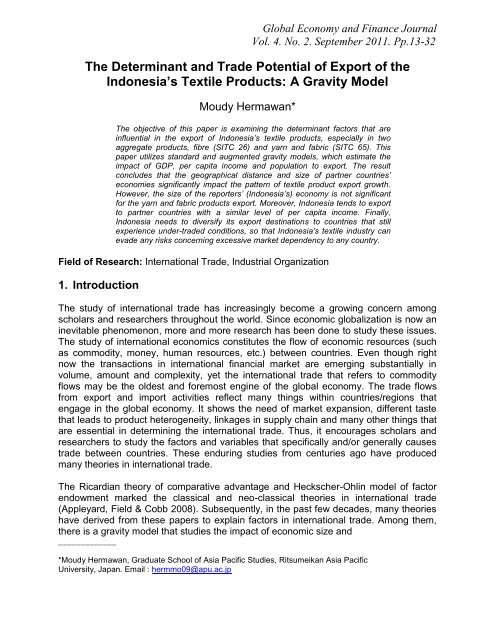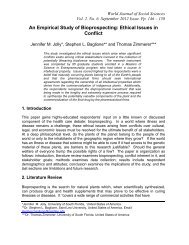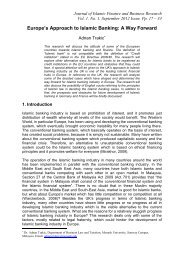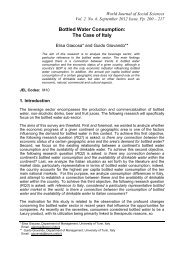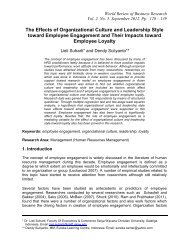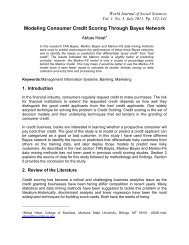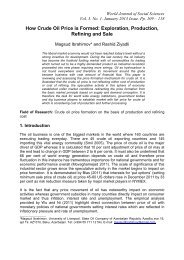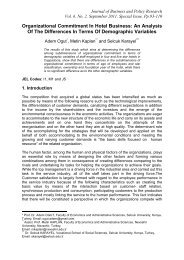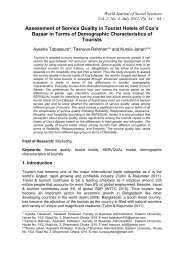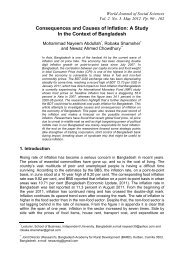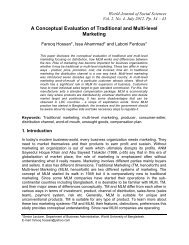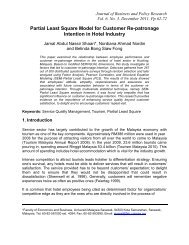The Determinant and Trade Potential of Export of the ... - Wbiaus.org
The Determinant and Trade Potential of Export of the ... - Wbiaus.org
The Determinant and Trade Potential of Export of the ... - Wbiaus.org
You also want an ePaper? Increase the reach of your titles
YUMPU automatically turns print PDFs into web optimized ePapers that Google loves.
Global Economy <strong>and</strong> Finance JournalVol. 4. No. 2. September 2011. Pp.13-32<strong>The</strong> <strong>Determinant</strong> <strong>and</strong> <strong>Trade</strong> <strong>Potential</strong> <strong>of</strong> <strong>Export</strong> <strong>of</strong> <strong>the</strong>Indonesia’s Textile Products: A Gravity ModelMoudy Hermawan*<strong>The</strong> objective <strong>of</strong> this paper is examining <strong>the</strong> determinant factors that areinfluential in <strong>the</strong> export <strong>of</strong> Indonesia’s textile products, especially in twoaggregate products, fibre (SITC 26) <strong>and</strong> yarn <strong>and</strong> fabric (SITC 65). Thispaper utilizes st<strong>and</strong>ard <strong>and</strong> augmented gravity models, which estimate <strong>the</strong>impact <strong>of</strong> GDP, per capita income <strong>and</strong> population to export. <strong>The</strong> resultconcludes that <strong>the</strong> geographical distance <strong>and</strong> size <strong>of</strong> partner countries’economies significantly impact <strong>the</strong> pattern <strong>of</strong> textile product export growth.However, <strong>the</strong> size <strong>of</strong> <strong>the</strong> reporters’ (Indonesia’s) economy is not significantfor <strong>the</strong> yarn <strong>and</strong> fabric products export. Moreover, Indonesia tends to exportto partner countries with a similar level <strong>of</strong> per capita income. Finally,Indonesia needs to diversify its export destinations to countries that stillexperience under-traded conditions, so that Indonesia’s textile industry canevade any risks concerning excessive market dependency to any country.Field <strong>of</strong> Research: International <strong>Trade</strong>, Industrial Organization1. Introduction<strong>The</strong> study <strong>of</strong> international trade has increasingly become a growing concern amongscholars <strong>and</strong> researchers throughout <strong>the</strong> world. Since economic globalization is now aninevitable phenomenon, more <strong>and</strong> more research has been done to study <strong>the</strong>se issues.<strong>The</strong> study <strong>of</strong> international economics constitutes <strong>the</strong> flow <strong>of</strong> economic resources (suchas commodity, money, human resources, etc.) between countries. Even though rightnow <strong>the</strong> transactions in international financial market are emerging substantially involume, amount <strong>and</strong> complexity, yet <strong>the</strong> international trade that refers to commodityflows may be <strong>the</strong> oldest <strong>and</strong> foremost engine <strong>of</strong> <strong>the</strong> global economy. <strong>The</strong> trade flowsfrom export <strong>and</strong> import activities reflect many things within countries/regions thatengage in <strong>the</strong> global economy. It shows <strong>the</strong> need <strong>of</strong> market expansion, different tastethat leads to product heterogeneity, linkages in supply chain <strong>and</strong> many o<strong>the</strong>r things thatare essential in determining <strong>the</strong> international trade. Thus, it encourages scholars <strong>and</strong>researchers to study <strong>the</strong> factors <strong>and</strong> variables that specifically <strong>and</strong>/or generally causestrade between countries. <strong>The</strong>se enduring studies from centuries ago have producedmany <strong>the</strong>ories in international trade.<strong>The</strong> Ricardian <strong>the</strong>ory <strong>of</strong> comparative advantage <strong>and</strong> Heckscher-Ohlin model <strong>of</strong> factorendowment marked <strong>the</strong> classical <strong>and</strong> neo-classical <strong>the</strong>ories in international trade(Appleyard, Field & Cobb 2008). Subsequently, in <strong>the</strong> past few decades, many <strong>the</strong>orieshave derived from <strong>the</strong>se papers to explain factors in international trade. Among <strong>the</strong>m,<strong>the</strong>re is a gravity model that studies <strong>the</strong> impact <strong>of</strong> economic size <strong>and</strong>_____________*Moudy Hermawan, Graduate School <strong>of</strong> Asia Pacific Studies, Ritsumeikan Asia PacificUniversity, Japan. Email : hermmo09@apu.ac.jp
Hermawangeographical distance to trade flows between bilateral countries or regions. <strong>The</strong> <strong>the</strong>orypioneered by Tinbergen (1962) <strong>and</strong> Pöyhönen (1963) studies <strong>the</strong> effect <strong>of</strong> nationalincome <strong>and</strong> geographical distance to imports <strong>of</strong> commodities 1 . Originated fromNewtonian <strong>the</strong>ory <strong>of</strong> universal gravity, <strong>the</strong> model postulates that <strong>the</strong> force between twoobjects is determined by <strong>the</strong>ir body mass <strong>and</strong> <strong>the</strong> distance between <strong>the</strong>m. Thus, in aneconophysics sense, <strong>the</strong> trade flow represents <strong>the</strong> gravitational force, <strong>the</strong> economicscale <strong>and</strong> wealth <strong>of</strong> two countries correspond to body mass <strong>of</strong> each subject, <strong>and</strong> <strong>the</strong>geographical distance is exactly <strong>the</strong> denotation <strong>of</strong> physical distance. Recently, thismodel is employed in social science problem solving in order to explain <strong>the</strong> flows <strong>of</strong> notonly trade but also immigrants <strong>and</strong> money repatriation, foreign direct investment, etc.This paper utilizes a gravity model to examine <strong>the</strong> bilateral export flows betweenIndonesia <strong>and</strong> selected trading partner countries, specifically in downstream <strong>and</strong>midstream textile industries (code 26 <strong>and</strong> 65 St<strong>and</strong>ard International <strong>Trade</strong>Classification/SITC Revision 3). <strong>The</strong> objectives <strong>of</strong> this research are tw<strong>of</strong>old: first,underst<strong>and</strong>ing <strong>the</strong> nature <strong>of</strong> Indonesian manufactured textile product exports. Withregard to <strong>the</strong> gravity model, <strong>the</strong> results should show <strong>the</strong> role <strong>of</strong> independent variables(economic size/wealth, geographical distance <strong>and</strong> o<strong>the</strong>r control variables) that influence<strong>the</strong> export. <strong>The</strong> results also determine <strong>the</strong> significance <strong>and</strong> direction <strong>of</strong> <strong>the</strong> effect. <strong>The</strong>second objective is to reveal <strong>the</strong> trade potential between Indonesia <strong>and</strong> its selectedtrading partners regarding <strong>the</strong> specific commodity. <strong>The</strong> estimation results from <strong>the</strong>gravity model will be <strong>the</strong> tool to predict <strong>the</strong> export value in <strong>the</strong> same trading partner <strong>and</strong><strong>the</strong> same period <strong>of</strong> analysis. <strong>The</strong>n, <strong>the</strong> comparison between predicted <strong>and</strong> actual exportvalue yields <strong>the</strong> projection <strong>of</strong> trade potential, which refers to under trade or overtradecircumstances between Indonesia <strong>and</strong> its trading partner. Ultimately, <strong>the</strong> purpose <strong>of</strong> thisresearch paper is to contribute to <strong>the</strong> study <strong>of</strong> international trade. Fur<strong>the</strong>rmore, it shouldillustrate <strong>the</strong> clear picture <strong>of</strong> <strong>the</strong> Indonesian manufactured textile industry, especially in<strong>the</strong> global market view. <strong>The</strong>refore, <strong>the</strong> hypo<strong>the</strong>ses <strong>of</strong> this research are:- <strong>The</strong> size <strong>of</strong> economy (GDP, per capita GDP <strong>and</strong> population) <strong>and</strong> <strong>the</strong> distancebetween Indonesia <strong>and</strong> its selected trading partner significantly influence <strong>the</strong> exportvalue <strong>of</strong> Indonesian textile industry;- Under <strong>the</strong> gravity model, <strong>the</strong> Indonesian textile industry is facing under traded <strong>and</strong>over traded situations with its selected trading partners.This paper is <strong>org</strong>anized as follows. Section 2 elaborates on <strong>the</strong> importance <strong>and</strong> <strong>the</strong>background problem in <strong>the</strong> Indonesian textile industry. Section 3 reviews <strong>the</strong> existingliterature which supports <strong>the</strong> <strong>the</strong>oretical implications <strong>and</strong> recent previous empiricalfindings <strong>of</strong> <strong>the</strong> gravity model. Section 4 presents <strong>the</strong> methodology <strong>and</strong> data <strong>of</strong> thisstudy, followed by analysis <strong>of</strong> <strong>the</strong> empirical findings in Section 5. Finally, Section 6provides <strong>the</strong> conclusion <strong>and</strong> limitations <strong>of</strong> <strong>the</strong> study.2. Indonesian Textile Industry<strong>The</strong> Indonesian textile industry consists <strong>of</strong> three mainstream industries: (i) <strong>the</strong> upstreamindustry which produces fibre (code 26 SITC Rev.3), (ii) <strong>the</strong> midstream industry whichmanufactures yarn <strong>and</strong> fabrics (code 65 SITC Rev.3), <strong>and</strong> (iii) <strong>the</strong> downstream industrywhich is <strong>the</strong> garment industry (code 84 SITC Rev.3) (Pratiwi Anwar 2000). For a14
Hermawantechnical reason, <strong>the</strong> term Indonesian textile industry in this paper henceforth refers toupstream <strong>and</strong> midstream industries only 2 . Prior to <strong>the</strong> 1960s, <strong>the</strong> small scale <strong>and</strong> somegovernment owned textile companies started to contribute to Indonesian GDP alongwith o<strong>the</strong>r primary goods industries such as food <strong>and</strong> beverage. However, <strong>the</strong>introduction <strong>of</strong> textile technology happened long before Indonesian independence.<strong>The</strong>n, in <strong>the</strong> mid 1970s, <strong>the</strong> industry started to produce import substitution goods inorder to fulfill domestic dem<strong>and</strong>s. In <strong>the</strong> 1970s, <strong>the</strong> textile industry was among <strong>the</strong> firstindustry to shift its paradigm to produce import substitution goods in <strong>the</strong> Indonesianmanufacturing industry. Within this period, several multinational textile companies(especially from Japan) established <strong>the</strong>ir plants, which revived <strong>the</strong> textile industry.However, most <strong>of</strong> <strong>the</strong>se multinationals were in <strong>the</strong> midstream (fabrics) industry, <strong>and</strong> <strong>the</strong>paradigm shifting began in 1975. On <strong>the</strong> o<strong>the</strong>r h<strong>and</strong>, <strong>the</strong> upstream (yarn <strong>and</strong> fibre)industry started to move to import substitution stage later in 1978 (Pratiwi Anwar 2000).<strong>The</strong> next development stage, export orientation or outward looking, was reached in1983 by <strong>the</strong> fabric industry. However, <strong>the</strong> yarn <strong>and</strong> fibre industry was lagging behindwhen it started to shift into <strong>the</strong> export orientation phase in 1997. Several governmentderegulations that coincided with <strong>the</strong> domestic global market situation have triggered<strong>the</strong> shifting in <strong>the</strong> textile industry from an inward looking to an outward lookingparadigm. Since <strong>the</strong> 1970s, <strong>the</strong> government has relaxed <strong>the</strong> investment <strong>and</strong> traderegulations to induce more domestic <strong>and</strong> (especially) foreign direct investment in <strong>the</strong>textile industry. <strong>The</strong> improvements <strong>of</strong> export administration <strong>and</strong> import liberalization(that decreased <strong>the</strong> tariff on imported input materials) have substantially encouraged <strong>the</strong>firms to export <strong>the</strong>ir products. Fur<strong>the</strong>rmore, currency devaluation policy in 1978,followed in 1985, has made <strong>the</strong> global market more favorable than <strong>the</strong> domestic market.O<strong>the</strong>r conditions initiating <strong>the</strong> shift in <strong>the</strong> textile industry are decreased labor costs in <strong>the</strong>1980s (Indian Council for Research on International Economic Relations (ICRIER)1995) combined with increase in <strong>the</strong> productivity <strong>of</strong> <strong>the</strong> textile industry. Lastly, <strong>the</strong>flourish <strong>of</strong> foreign direct investment all over <strong>the</strong> world has increased East Asianmultinationals investment in <strong>the</strong> 1980s to 1990s (Osada 1994).From <strong>the</strong> beginning <strong>of</strong> <strong>the</strong> development stage until recently, <strong>the</strong> textile industry hasbeen contributing to Indonesia’s economy particularly in total output, labor absorption,foreign direct investment <strong>and</strong> export. <strong>The</strong> decline <strong>of</strong> importance <strong>of</strong> <strong>the</strong> textile industry ismainly because <strong>of</strong> rapid growth <strong>of</strong> o<strong>the</strong>r manufacturing industry sectors, such as food<strong>and</strong> beverage, electronic, chemical, pharmaceutical <strong>and</strong> automotive.15
HermawanIn terms <strong>of</strong> its share to Indonesia’s total export, <strong>the</strong> textile industry is in position number7 among <strong>the</strong> 10 largest exported products (<strong>of</strong> 66 divisions/ two digits SITC Rev.3) inIndonesia in 2004-2009 as shown in <strong>the</strong> Figure 1. <strong>The</strong>se products account for almost60% <strong>of</strong> total export, <strong>and</strong> <strong>the</strong> textile industry share is 4.52% <strong>of</strong> total export. While <strong>the</strong>largest exported products are from <strong>the</strong> food <strong>and</strong> beverage sector (fixed vegetable oils<strong>and</strong> fats) followed by <strong>the</strong> mineral sector (coal, metalliferous ores <strong>and</strong> metal).Fur<strong>the</strong>rmore, <strong>the</strong> role <strong>of</strong> <strong>the</strong> Indonesian textile industry in international trade is also veryimportant. In 2008, <strong>the</strong> Indonesian textile industry is <strong>of</strong> <strong>the</strong> 15 th rank for textile yarn <strong>and</strong>fabrics (SITC 65) exporters in <strong>the</strong> world. It contributes 1.50% <strong>of</strong> <strong>the</strong> total world exports<strong>of</strong> textiles as expressed in Table 1.16
HermawanTable 120 Largest Textile World <strong>Export</strong>er, 2008Rank CountrySITC 65SITC 26CountryValue (US$) Share Value (US$) Share1 China 65.366.583.459 26,70% USA 6.867.422.882 23,04%2 Italy 16.091.507.199 6,57% Australia 2.341.243.151 7,86%3 Germany 15.901.460.000 6,50% Germany 2.204.633.000 7,40%4 USA 12.470.256.158 5,09% China 2.036.930.548 6,83%5 Hong Kong SAR 12.256.104.656 5,01% India 2.029.642.171 6,81%6 India 10.372.330.047 4,24% Rep. <strong>of</strong> Korea 1.268.691.843 4,26%7 Turkey 9.399.326.853 3,84% Japan 1.209.203.904 4,06%8 Belgium 8.135.642.051 3,32% Belgium 934.966.242 3,14%9 France 7.367.407.581 3,01% Brazil 870.352.859 2,92%10 Japan 7.340.457.412 3,00% United Kingdom 751.817.664 2,52%11 Pakistan 7.186.246.049 2,94% Thail<strong>and</strong> 513.495.647 1,72%12 Ne<strong>the</strong>rl<strong>and</strong>s 4.807.457.396 1,96% Italy 506.450.296 1,70%13 United Kingdom 4.445.613.921 1,82% France 473.491.661 1,59%14 Spain 4.355.743.982 1,78% Indonesia 454.636.464 1,53%15 Indonesia 3.674.528.238 1,50% New Zeal<strong>and</strong> 432.988.926 1,45%16 Thail<strong>and</strong> 3.211.358.519 1,31% Greece 357.864.777 1,20%17 Czech Rep. 2.725.500.806 1,11% Turkey 302.773.346 1,02%18 Austria 2.248.755.576 0,92% Ne<strong>the</strong>rl<strong>and</strong>s 296.946.994 1,00%19 Pol<strong>and</strong> 2.173.645.375 0,89% Czech Rep. 266.196.835 0,89%20 Mexico 1.993.163.229 0,81% South Africa 260.784.327 0,87%Source : Computed from UN COMTRADE databaseIn addition, <strong>the</strong> industry also holds <strong>the</strong> 14 th position among fibre (SITC 26) exporters in<strong>the</strong> world, with 1.53% contribution to total world exports. From <strong>the</strong> table above we knowthat Indonesia <strong>and</strong> Thail<strong>and</strong> are <strong>the</strong> largest textile exporters in ASEAN. Accordingly,China, India <strong>and</strong> Japan are consistently in <strong>the</strong> largest textile world exporter group with<strong>the</strong> United States <strong>and</strong> o<strong>the</strong>r European Union (EU) members (Germany, Belgium, UnitedKingdom, France, Italy <strong>and</strong> Ne<strong>the</strong>rl<strong>and</strong>s).<strong>The</strong> export trend <strong>of</strong> Indonesian textile products in <strong>the</strong> last two decades, 1989-2009,shows steady high growth for textile yarn <strong>and</strong> fabric products (figure 2). Moreover, <strong>the</strong>trend is less volatile with slightly seasonal adjustment. Even in <strong>the</strong> 1997-1998 crises <strong>the</strong>export value dropped only about 27% <strong>and</strong> recovered by 16% in <strong>the</strong> next year.However, <strong>the</strong> fibre export products growth rate told <strong>the</strong> different story. <strong>The</strong> growth trendis very flat <strong>and</strong> <strong>the</strong> export value is relatively small compared to <strong>the</strong> textile fabric product.Thus, this fact is consistent with <strong>the</strong> hypo<strong>the</strong>sis that <strong>the</strong> fibre industry is lagging behind,17
Hermawanin terms <strong>of</strong> paradigm shifting from import substitution to export orientation as mentionedbefore.Ano<strong>the</strong>r aspect that demonstrates <strong>the</strong> real condition <strong>of</strong> <strong>the</strong> Indonesian textile industry isits export destination. <strong>The</strong> calculation <strong>of</strong> Indonesian textile export to its 40 major partnercountries data in 2008 evinces that most <strong>of</strong> Indonesian textile yarn <strong>and</strong> fabric productsare exported to East Asian, West European <strong>and</strong> ASEAN countries in that order.Additionally, for fibre products, over 50% <strong>of</strong> its export destination is to West European,South Asian <strong>and</strong> East Asian countries respectively (Table 2).Table 2Indonesian Textile Industry <strong>Export</strong> Destination, 2008(taken from 40 major countries export partner)RegionYarn &FabricsFibreGDPsharesPopulationsharesEast Asia 22,98% 13,70% 18,97% 22,92%West Europe 19,00% 27,73% 14,17% 2,81%ASEAN 13,69% 8,75% 2,12% 8,53%West & Central Asia 9,14% 7,62% 3,46% 4,21%South America 7,95% 1,83% 3,83% 5,70%North & CentralAmerica 7,68% 12,28% 30,78% 7,33%South Asia 5,81% 15,98% 3,07% 24,73%Africa 3,08% 1,86% 2,32% 14,60%Oceania 1,05% 2,97% 1,92% 0,51%East Europe 0,80% 0,22% 3,82% 4,35%Source : computed from UNCOMTRADE databaseIn order to correlate <strong>the</strong> fact about Indonesian textile product export destinations with<strong>the</strong> gravity model, Table 2 has included <strong>the</strong> proportion <strong>of</strong> each region GDP’s <strong>and</strong>population with <strong>the</strong> world’s GDP <strong>and</strong> Population, in <strong>the</strong> last two columns. Thus, we cancompare <strong>the</strong> proportion <strong>of</strong> Indonesian major textile export destinations with <strong>the</strong> region’seconomic size <strong>and</strong> wealth, which is represented by GDP <strong>and</strong> population.It should be noted that <strong>the</strong> proportion <strong>of</strong> <strong>the</strong> region’s GDP <strong>and</strong> population shown in <strong>the</strong>table above include all country members <strong>of</strong> <strong>the</strong> region. On <strong>the</strong> o<strong>the</strong>r h<strong>and</strong>, <strong>the</strong>proportion <strong>of</strong> Indonesian textile product export destinations does not include all <strong>the</strong>members <strong>of</strong> <strong>the</strong> region, only <strong>the</strong> 40 major Indonesian export partners. Never<strong>the</strong>less,<strong>the</strong>se 40 major trading partners comprise over 90% <strong>of</strong> Indonesian textile exports to <strong>the</strong>world. Thus, it is still reasonable to compare <strong>the</strong> proportion <strong>of</strong> Indonesian textileproducts export destination with its partner’s GDP <strong>and</strong> Population share to <strong>the</strong> world.From Figure 3, which is a graphical depiction <strong>of</strong> Table 2, we can easily visualize that<strong>the</strong>re was inequality between <strong>the</strong> Indonesian textile product export destinationscompared to its trading partners economic size. <strong>The</strong> export to East Asian countriesrepresents <strong>the</strong> most balanced proportion <strong>of</strong> export destination <strong>and</strong> economic size. <strong>The</strong>gap between export proportion <strong>and</strong> economic size is relatively narrow. Conversely,West European countries absorb reasonably high Indonesian textile products, while itspopulation is very small compared to o<strong>the</strong>r regions. Ano<strong>the</strong>r example is in <strong>the</strong> North <strong>and</strong>18
HermawanCentral America region. <strong>The</strong> export <strong>of</strong> textile products from Indonesia to this region isrelatively <strong>the</strong> same size compared to ASEAN countries, for instance. However, thisregion’s GDP is <strong>the</strong> highest in <strong>the</strong> world.Ultimately, <strong>the</strong>se rough calculations above may indicate undiversified exportdestinations <strong>of</strong> Indonesian textile products. <strong>The</strong>refore, it is also a sign <strong>of</strong> under trade orover trade between Indonesia <strong>and</strong> its trading partner. <strong>The</strong> case <strong>of</strong> an excessive orovertrade situation may increase <strong>the</strong> international trading risk for Indonesia. Forexample, if <strong>the</strong>re is any economic, political or social turbulence in <strong>the</strong> country which hasexcessive export products from Indonesia, <strong>the</strong>n Indonesia will suffer if its exportsdecrease abruptly. Conversely, in any country that experiences under trade withIndonesia, <strong>the</strong>re are potential market expansions for Indonesia that will minimize <strong>the</strong>international trading risk.3. <strong>The</strong> Gravity Model<strong>The</strong> gravity model is derived from <strong>the</strong> physics law <strong>of</strong> <strong>the</strong> universal gravitational force.This concept <strong>the</strong>n is utilized to explain <strong>the</strong> flow in social science issues such as tradeflows, capital flows (FDI & money repatriation), <strong>and</strong> human (migration) among countries.<strong>The</strong> original specification <strong>of</strong> Newton’s Law for <strong>the</strong> gravitational force <strong>of</strong> two objects i <strong>and</strong>j is expressed as:GF ij = M i M j(D ij ) 2(1)In this equation, <strong>the</strong> gravitational force (GF) is directly proportional to <strong>the</strong> product <strong>of</strong> <strong>the</strong>masses (M) <strong>of</strong> <strong>the</strong> objects <strong>and</strong> is inversely proportional to <strong>the</strong> square <strong>of</strong> <strong>the</strong> distance (D)between <strong>the</strong>m. <strong>The</strong> early application <strong>of</strong> this equation in international trade study is in areduced form. <strong>The</strong> new form omits <strong>the</strong> square <strong>of</strong> <strong>the</strong> distance <strong>and</strong> transforms <strong>the</strong>equation into (natural) logarithms. In this form, <strong>the</strong> gravitational force is replaced by19
Hermawantrade flows (exports <strong>and</strong>/or imports) as <strong>the</strong> dependent variable. Fur<strong>the</strong>rmore, <strong>the</strong>national income (GDP) represents <strong>the</strong> body mass <strong>and</strong> <strong>the</strong> physical distance is still in itsoriginal form. Thus, <strong>the</strong> early gravity model <strong>of</strong> trade flows is as follows:Ln(TF ij ) = LnGDP i + LnGDP j - LnD ij where i ≠ j (2)<strong>The</strong> equation above simply explains that <strong>the</strong> trade flow (TF) between two countries (i &j) is <strong>the</strong> function <strong>of</strong> <strong>the</strong> GDP <strong>of</strong> i <strong>and</strong> j <strong>and</strong> <strong>the</strong> physical distance between <strong>the</strong>m.Moreover, <strong>the</strong> GDP represents market size <strong>and</strong> purchasing power <strong>of</strong> trade partnerswhile <strong>the</strong> distance is <strong>the</strong> rough measurement <strong>of</strong> physical distance between <strong>the</strong>m.<strong>The</strong>oretical ConsiderationsDespite <strong>the</strong> empirical success in explaining international trade patterns (Bergstr<strong>and</strong>1985) <strong>and</strong> regional trade blocks, <strong>the</strong> <strong>the</strong>oretical underpinnings <strong>of</strong> <strong>the</strong> gravity model havenot yet been justified. Thus, some critics have attacked <strong>the</strong> gravity model for its lack <strong>of</strong><strong>the</strong>oretical justification. Subsequently, several researchers attempted to reconcile <strong>the</strong>international trade <strong>the</strong>ories with <strong>the</strong> gravity model. One <strong>of</strong> <strong>the</strong> first attempts to derive <strong>the</strong>gravity model from international trade <strong>the</strong>ory is Anderson (1979). Under completespecialization, no tariff, no transportation costs <strong>and</strong> homo<strong>the</strong>tic preference assumptions,he found that <strong>the</strong> gravity equation can be rearranged from a simple/pure <strong>and</strong> tradeshareexpenditure system. Additionally, he also justified <strong>the</strong> equation with <strong>the</strong>assumption <strong>of</strong> many goods, tariff <strong>and</strong> distance. In his conclusion, he emphasized that<strong>the</strong> gravity equity equation can be derived from <strong>the</strong> properties <strong>of</strong> an expenditure system.Afterward, Jeffrey Bergstr<strong>and</strong> perhaps was <strong>the</strong> most praised scholar in 1980s thatcontinuously worked in <strong>the</strong> <strong>the</strong>oretical study <strong>of</strong> <strong>the</strong> gravity model. FollowingLinnemann's (1966) work, Bergstr<strong>and</strong> (1985) attempted to develop a <strong>the</strong>oreticalfoundation for <strong>the</strong> gravity model from <strong>the</strong> partial equilibrium model. Starting withconstant-elasticity <strong>of</strong> substitution (CES) function, he showed that equilibrium <strong>of</strong> exportsupply <strong>and</strong> import dem<strong>and</strong> leads to <strong>the</strong> original gravity equation (before loglineartransformation). Of course, he conducted it under certain assumptions: small (relative)market <strong>of</strong> aggregate trade flows, identical utility <strong>and</strong> production functions, perfect goodssubstitutability, perfect commodity arbitrage, zero tariffs <strong>and</strong> zero transport costs. In <strong>the</strong>successive study, Bergstr<strong>and</strong> (1989) employed monopolistic competition model <strong>of</strong> Dixit<strong>and</strong> Stiglitz (1977) with <strong>the</strong> assumption <strong>of</strong> differentiated goods among firms ra<strong>the</strong>r thancountries. In his later work, Bergstr<strong>and</strong> (1990) added Linder's hypo<strong>the</strong>sis 3 in his modelto capture <strong>the</strong> income differential effect. Additionally, in order to deal with <strong>the</strong> critics <strong>of</strong>his assumption, he incorporated a GDP deflator as <strong>the</strong> proxy <strong>of</strong> price <strong>and</strong> physicaldistance <strong>and</strong> dummy variable for tariffs.Ano<strong>the</strong>r well cited <strong>the</strong>oretical research on <strong>the</strong> gravity model is <strong>the</strong> study by Deardorff(1998). In his paper, Deardorff derived <strong>the</strong> gravity equation from rudimentaryinternational trade <strong>the</strong>ory <strong>of</strong> <strong>the</strong> Heckscher-Ohlin (HO) model, especially, in two extremecases: frictionless trade <strong>and</strong> <strong>the</strong> existence <strong>of</strong> trade impediments. In <strong>the</strong> first case, heproved that <strong>the</strong> gravity equation can simply be derived from <strong>the</strong> st<strong>and</strong>ard HO model,ei<strong>the</strong>r in homo<strong>the</strong>tic or arbitrary preference assumption. In <strong>the</strong> latter case, impededtrade, he demonstrated that from st<strong>and</strong>ard HO model with transport costs, he couldobtain <strong>the</strong> original gravity equation, both with Cobb-Douglas <strong>and</strong> CES preferences. In20
Hermawanhis conclusion, Deardorff stated that even a simple gravity equation can be derived fromst<strong>and</strong>ard <strong>the</strong>ories. Fur<strong>the</strong>rmore, he suggests that any international trade model will beconsistent with gravity equation.Perhaps <strong>the</strong>re are numerous studies that explore <strong>the</strong>oretical considerations for <strong>the</strong>gravity model. Ranging in assumptions <strong>and</strong> preferences, <strong>the</strong>se studies have proven that<strong>the</strong> gravity equation can be derived from any <strong>the</strong>ories <strong>of</strong> international trade.Never<strong>the</strong>less, <strong>the</strong> reader may wish to refer <strong>the</strong> studies <strong>of</strong> Anderson <strong>and</strong> van Wincoop(2001, 2004); Helpman <strong>and</strong> Krugman (1987); Shiro Armstrong (2007); Evenett & Keller(2002); <strong>and</strong> Harrigan (2001) for more detailed <strong>and</strong> recent contributions on <strong>the</strong>oreticalfindings <strong>of</strong> <strong>the</strong> gravity model.Previous Empirical WorksEver since <strong>the</strong> pioneer studies by Tinbergen (1962) <strong>and</strong> Pöyhönen (1963), <strong>the</strong>re havebeen abundant studies that empirically test trade flows using <strong>the</strong> gravity model.However, <strong>the</strong>se studies are too many to describe in this paper. <strong>The</strong>refore, I only discusssome recent papers that are related to this study, in which <strong>the</strong>y differ only in certainaspects.As known by its form, <strong>the</strong> gravity model is useful in assessing bilateral trade betweencountries. Thus, it means that <strong>the</strong> gravity model is applicable to at least two cases. <strong>The</strong>first case is trade between multiple countries with <strong>the</strong>ir multiple partners. Usually, <strong>the</strong>objective <strong>of</strong> <strong>the</strong> model is to evaluate a regional trade block/area such as NAFTA,Eurozone, MERCOSUR, CAFTA, etc. For more detailed surveys <strong>of</strong> this case, <strong>the</strong> readermay refer to <strong>the</strong> following papers: Roberts (2004, 2005) tested <strong>the</strong> impact <strong>of</strong> <strong>the</strong>proposed China-ASEAN free trade area. Kharel <strong>and</strong> Belbase (2010) investigated <strong>the</strong>trade flow <strong>of</strong> <strong>the</strong> group <strong>of</strong> l<strong>and</strong>locked developing countries (LLDC) to propose <strong>the</strong>integrated trading system between <strong>the</strong>m <strong>and</strong> improve <strong>the</strong>ir engagement in internationaltrade. Hapsari <strong>and</strong> Mangunsong (2006) studied <strong>the</strong> determinant factors <strong>of</strong> ASEAN freetrade area (AFTA) members’ export <strong>and</strong> explore <strong>the</strong> impact <strong>of</strong> trade creation/diversion,factor endowment differences <strong>and</strong> export structure similarity. Salim <strong>and</strong> Kabir (2010)assessed <strong>the</strong> success <strong>of</strong> ASEAN regional integration compared to Europe Union (EU)countries trade integration. Lankhuizen, De Groot <strong>and</strong> Linders (2009) studied <strong>the</strong>trade<strong>of</strong>f between foreign direct investment <strong>and</strong> export within OECD countries. Fratianni(2007) empirically evaluated gravity model, which covering trade in 143 countries, thatseparated into north (OECD) <strong>and</strong> south (non OECD) countries. Lastly, Zarsoso <strong>and</strong>Lehman (2003) examined <strong>the</strong> trade flows between 5 MERCOSUR members plus Chile<strong>and</strong> 15 EU countries.<strong>The</strong> second case is <strong>the</strong> trade between countries with <strong>the</strong>ir multiple trading partners. <strong>The</strong>primary objective <strong>of</strong> this study is to characterize <strong>the</strong> determinant factors <strong>of</strong> <strong>the</strong> gravitymodel. However, recently many scholars have included more variables to <strong>the</strong> traditionalgravity model to capture o<strong>the</strong>r aspects that may influence <strong>the</strong> trade flows <strong>and</strong> to assesstrade potential between a country <strong>and</strong> its trading partner. Several researchers haveutilized <strong>the</strong> gravity model to evaluate bilateral trade flows <strong>of</strong> aggregate or specificproducts in a specific country: Australia (Rahman 2009), Cambodia (Kim 2006), China(Gu 2008), wood products <strong>of</strong> South Africa (Eita & Jordaan 2007), United States (Leitão2010), <strong>and</strong> specially frozen tart cherry product <strong>of</strong> United States (Aguilar 2006), Fiji (Ram21
Hermawan& Prasad 2007), Ne<strong>the</strong>rl<strong>and</strong>s (Földvári 2006), marine products <strong>of</strong> Icel<strong>and</strong>(Kristjansdottir 2005), <strong>and</strong> India (Prabir De 2009). Please note that <strong>the</strong>seaforementioned papers are perhaps only a small part <strong>of</strong> numerous studies <strong>of</strong> <strong>the</strong> gravitymodel using <strong>the</strong> single country reporter perspective.Recently, <strong>the</strong> empirical research in international trade using <strong>the</strong> gravity model hasbecome more “augmented” in terms <strong>of</strong> <strong>the</strong> number <strong>of</strong> regressors <strong>and</strong> estimationtechniques. <strong>The</strong> supplementary variables vary in terms <strong>of</strong>:- Size <strong>of</strong> economy (in addition <strong>of</strong> national income): population, per capita GDP,per capita income differentials- Geographical distance (in addition <strong>of</strong> physical distance): nautical miles,remoteness, proximity- <strong>Trade</strong> restrictions: tariffs, relative exchange rates- Dummy variables to control qualitative aspects <strong>of</strong> <strong>the</strong> model: commoncultures (languages, colonization), common regional trade agreements,spatial (common border, l<strong>and</strong>locked, coastal)Fur<strong>the</strong>rmore, <strong>the</strong> development <strong>of</strong> econometrics has supported <strong>the</strong> improvement <strong>of</strong>regression methods from <strong>the</strong> cross section to panel data analysis which capture <strong>the</strong>dynamics <strong>of</strong> <strong>the</strong> time invariant in trade data. Never<strong>the</strong>less, <strong>the</strong> variation in a number <strong>of</strong>regressors <strong>and</strong> estimation methods that are utilized in <strong>the</strong> gravity model has surprisinglynot reduced <strong>the</strong> power <strong>of</strong> <strong>the</strong> model to explain bilateral trade between countries.4. Methodology <strong>and</strong> DataThis paper follows <strong>the</strong> recent empirical research in <strong>the</strong> gravity model, which augmented<strong>the</strong> traditional model into several additional models. <strong>The</strong>refore, in examining <strong>the</strong> bilateralexport <strong>of</strong> Indonesian textile products, I include additional regressors <strong>and</strong> employ paneldata regression. <strong>The</strong> first model is <strong>the</strong> st<strong>and</strong>ard gravity model:LnEXP it = β 0 + β 1 LnY I t + β 2 LnY it + β 3 LnDist i + u it (3)Moreover, in order to capture <strong>the</strong> impact <strong>of</strong> o<strong>the</strong>r qualitative aspects, we modified <strong>the</strong>model (3) by including binary regressors (dummies):LnEXP it = β 0 + β 1 LnY I t + β 2 LnY it + β 3 LnDist i + β 4 DASEAN +β 5 DAPEC + β 6 DBorder + u it(4)Where EXP it denotes export value <strong>of</strong> Indonesia to its (i) trading partners in period (t)respectively, Y I t, Y it , D i are <strong>the</strong> GDP <strong>of</strong> Indonesia <strong>and</strong> country i in period t respectively,<strong>and</strong> D is <strong>the</strong> geographical distance between Indonesia <strong>and</strong> country i which is timeinvariant. <strong>The</strong> dummy variable would take <strong>the</strong> number 1 if country i is a member <strong>of</strong>ASEAN or APEC <strong>and</strong> shared common border with Indonesia, <strong>and</strong> zero if o<strong>the</strong>rwise.Finally, u it is <strong>the</strong> identically <strong>and</strong> independently distributed error-terms.22
HermawanAs pointed out in <strong>the</strong> previous section, national income (expressed in GDP) variablesare expected to have a positive impact on exports. Fur<strong>the</strong>rmore, Indonesian GDP <strong>and</strong>exports are likely to be in an endogenous relationship, since in <strong>the</strong> macroeconomicequation, GDP is formed partly by net foreign trade. However, in a similar case, <strong>the</strong>estimation results showed <strong>the</strong>se were slightly different estimates from a st<strong>and</strong>ardregression <strong>and</strong> <strong>the</strong>refore, for <strong>the</strong> sake <strong>of</strong> simplicity, Y I t is h<strong>and</strong>led as exogenous(Földvári 2006). <strong>The</strong> effect <strong>of</strong> geographical distance is negative to export, since itreflects transport costs. Lastly, <strong>the</strong> influence <strong>of</strong> dummy variables, common regionaltrade agreements (RTA) <strong>and</strong> shared borders, is supposed to be positive. It is naturalsince <strong>the</strong> purpose <strong>of</strong> RTA is to encourage trade between members. Fur<strong>the</strong>rmore, <strong>the</strong>same as <strong>the</strong> distance variable, neighboring countries tend to trade more ra<strong>the</strong>r th<strong>and</strong>istant countries.As an alternative specification, I replace national income with population, per capitaincome <strong>and</strong> per capita income differential in <strong>the</strong> model:LnEXP it =β 0 + β 1 LnP I t + β 2 LnP it + β 3 LnYPc I t + β 4 LnYPc it + β 5 LnDist i+ β 6 Ln∆Ypc I it + β 7 DASEAN + β 8 DAPEC + β 9 DBorder + u it(5)Where YPc I t,YPc it ,Pβ 6 I t, LnDIST <strong>and</strong> P i it+ are β 7 DASEAN GDP per + capita β 8 DAPEC income + β 9 <strong>and</strong> DBorder population + u it <strong>of</strong> Indonesia<strong>and</strong> country i, in time t respectively, <strong>and</strong> ∆Ypc I it is per capita income difference betweenIndonesia <strong>and</strong> country i, in time t respectively. From ma<strong>the</strong>matical perspective, thisreplacement does not make any difference since:LnY = Ln(YPc x P) = LnYPc + LnP (6)However, from an econometrics viewpoint, <strong>the</strong> results might be slightly different. <strong>The</strong>per capita income <strong>of</strong> Indonesia <strong>and</strong> its trading partner impact to export is expected to bepositive, since higher income means a larger market to exp<strong>and</strong> (in <strong>the</strong> view <strong>of</strong> exportingor importing country). <strong>The</strong>refore, higher per capita countries tend to trade each o<strong>the</strong>r.Fur<strong>the</strong>rmore, as noted earlier, <strong>the</strong> addition <strong>of</strong> per capita income differential is toevaluate whe<strong>the</strong>r <strong>the</strong> export pattern follows Linder's hypo<strong>the</strong>sis. Thus, <strong>the</strong> negative sign<strong>of</strong> <strong>the</strong> coefficient means that <strong>the</strong> model supports Linder's hypo<strong>the</strong>sis <strong>and</strong> vice versa.<strong>The</strong> impact <strong>of</strong> population (both Indonesia <strong>and</strong> partner countries) cannot be indicated apriori, since <strong>the</strong> effect can flow in a different direction. Large population means asubstantial domestic market <strong>and</strong> higher degree <strong>of</strong> self sufficiency. Thus, <strong>the</strong>y usuallytend to refrain exporting <strong>the</strong>ir products. However, large population also encourageshigher labor division, higher economies <strong>of</strong> scale <strong>and</strong> finally, opportunity to trade in moredifferentiated goods.This paper utilizes panel data regression to estimate <strong>the</strong> models above. <strong>The</strong> estimationmethods in this study are estimated generalized least square (EGLS) with a weightedcross section to control contemporaneous heteroscedasticity in cross section data.Fur<strong>the</strong>rmore, <strong>the</strong> model estimation should run thoroughly in both fabric products (SITC65) <strong>and</strong> yarn <strong>and</strong> fibre products (SITC 26) data. In order to assess <strong>the</strong> potential trade, Iutilize <strong>the</strong> results <strong>of</strong> st<strong>and</strong>ard gravity model estimation. Accordingly, <strong>the</strong> trade success is<strong>the</strong> comparative measurement between actual trade <strong>and</strong> potential trade:<strong>Trade</strong> Success =Actual <strong>Trade</strong><strong>Potential</strong> <strong>Trade</strong>23
HermawanIf <strong>the</strong> actual trade is smaller than potential trade, it is a sign <strong>of</strong> under trade phenomenonbetween Indonesia <strong>and</strong> its trading partner countries. <strong>The</strong>refore, it means <strong>the</strong>re arepossibilities to export more to <strong>the</strong>se countries. Conversely, if actual trade is larger thanpotential trade, it is a sign <strong>of</strong> over trade. In <strong>the</strong> over trade case, it does not necessarilymean that Indonesia should reduce <strong>the</strong> export level to <strong>the</strong>se countries. However, itreveals a risk <strong>of</strong> possible loss if Indonesia’s exports are excessively large to anycountry.<strong>The</strong> data collected in this paper are time series data from 2000-2008 in a cross section<strong>of</strong> 26 countries (Indonesia, Australia, Bangladesh, Brazil, Canada, China, HongkongSAR, Egypt, France, Germany, India, Italia, Japan, Malaysia, Mexico, Ne<strong>the</strong>rl<strong>and</strong>,Pakistan, Philippines, South Korea, Russia, Saudi Arabia, Singapore, Spain, Thail<strong>and</strong>,United Kingdom, <strong>and</strong> United States <strong>of</strong> America) which are r<strong>and</strong>omly selected fromIndonesia’s major trading partner countries in each continent. Fur<strong>the</strong>rmore, <strong>the</strong>seselected countries comprise almost 70% <strong>of</strong> Indonesia total export. <strong>The</strong> following tabledepicts detailed data explanation <strong>of</strong> each variable.VariableNameSummary<strong>Export</strong> Total <strong>Export</strong> value. Reporter :Indonesia, Partner : 25selected countriesGDP GDP value at 2005 constantpricePopulation De facto population in acountry, area or region as <strong>of</strong> 1July <strong>of</strong> <strong>the</strong> yearPer capitaincome∆per capitaincomeGDP per head calculated as<strong>the</strong> aggregate <strong>of</strong> production(GDP) divided by <strong>the</strong>population size.Absolute value <strong>of</strong> per capitaincome difference betweenIndonesia <strong>and</strong> country iDistance Geographical distancemeasured in Nautical miles.Since <strong>the</strong> cargo <strong>of</strong> exportedtextile products travelsthrough seas/oceans.DummyVariablesMembership <strong>of</strong> ASEAN <strong>and</strong>APEC, Border: shared borderwith IndonesiaTable 3Variable ExplanationsSourceUnited Nations Commodity <strong>Trade</strong> Statistics Database(UN COMTRADE) accessed through World Integrated<strong>Trade</strong> Solution (WITS)United Nations Statistics Division (UN STATS),National Account Main Aggregate DatabaseUN STATS, National Account Main AggregateDatabaseUN STATS, National Account Main AggregateDatabaseComputed by author from UN STATS, NationalAccount Main Aggregate DatabaseGeoDataSource Distance Calculator,http://www.geodatasource.com/distancecalculator.aspxhttp://www.aseansec.<strong>org</strong>/, www.apec.<strong>org</strong>Finally, Appendix 1 presents <strong>the</strong> detailed descriptive statistics <strong>of</strong> <strong>the</strong> data used in thisresearch paper.5. Estimation ResultsTable 4 <strong>and</strong> 5 show <strong>the</strong> GLS estimation results <strong>of</strong> <strong>the</strong> gravity model estimated with Eviews6.0. As explained in <strong>the</strong> previous section, this paper estimates two gravity models. First, <strong>the</strong>24
Hermawanestimation <strong>of</strong> st<strong>and</strong>ard gravity model with national income, geographical distance <strong>and</strong>dummy variables. Second, <strong>the</strong> estimation <strong>of</strong> augmented gravity model with <strong>the</strong> population,per capita income <strong>and</strong> per capita income difference as an additive variable. Each tablepresents regression results <strong>of</strong> yarn <strong>and</strong> fabric (SITC 65) products <strong>and</strong> fibre (SITC 26)products. <strong>The</strong>refore, in this section I discuss <strong>the</strong> results <strong>of</strong> two proposed models within twoaggregated products.Table 4St<strong>and</strong>ard Gravity Model Estimation ResultsREGRESSORS SITC 65 (Yarn & Fabrics) SITC 26 (Fibres)C 15.16702 3.814980 (3.975648)*** -45.81505 7.336372 (-6.244919)***LnY I 0.036355 0.140233 (0.259247) 2.554787 0.243715 (10.48267)***LnY 0.378925 0.011600 (32.66610)*** 0.422063 0.063701 (6.625660)***LnDist -1.002886 0.050322 (-19.92931)*** -2.184271 0.106890 (-20.43473)***DASEAN -0.159599 0.076126 (-2.096497)** -1.972264 0.154751 (-12.74472)***DAPEC -0.247325 0.020729 (-11.93144)*** 0.005506 0.144014 (0.038232)DBORDER -0.245762 0.070239 (-3.498964)*** -0.598574 0.085537 (-6.997871)***(Pool) Observations 250 250R 2 0.645373 0.589258- Coefficient in bold, st<strong>and</strong>ard error in italic, t statistics in paren<strong>the</strong>ses- * significant in 10%, ** significant in 5%, *** significant in 1%<strong>The</strong> estimation results <strong>of</strong> <strong>the</strong> st<strong>and</strong>ard gravity model for yarn <strong>and</strong> fabric products in table4 show that GDP <strong>of</strong> Indonesia is not significant in affecting <strong>the</strong> value <strong>of</strong> fabrics productsexport. <strong>The</strong> reason is perhaps that Indonesia is in <strong>the</strong> phase <strong>of</strong> export orientation, so <strong>the</strong>size <strong>of</strong> its national income does not impact <strong>the</strong> level <strong>of</strong> export value. As expected, <strong>the</strong>trading partners’ GDP positively influences <strong>the</strong> export value, <strong>and</strong> <strong>the</strong> geographicaldistance has a negative impact. However significantly, all <strong>the</strong> dummy variables havenegative effect on export value. <strong>The</strong> result is inconsistent with <strong>the</strong> expected effect, thatneighboring countries <strong>and</strong> shared members <strong>of</strong> international <strong>org</strong>anization should createmore trade cooperation. This fact does not necessarily mean that becoming a member<strong>of</strong> regional/international <strong>org</strong>anization would discourage trade. <strong>The</strong> possibility is <strong>the</strong>different role or policy in international trade <strong>of</strong> textile products within <strong>the</strong> countrymembers, since <strong>the</strong>y are just cooperation forums, so <strong>the</strong>y do not have specific tradingagreement. In addition, this may occur as <strong>the</strong> consequence <strong>of</strong> declining export trend tosome ASEAN <strong>and</strong> APEC member during this period.On <strong>the</strong> o<strong>the</strong>r h<strong>and</strong>, <strong>the</strong> estimation results <strong>of</strong> fibre products present slightly differentfacts. <strong>The</strong> GDP <strong>of</strong> Indonesia still has a positive significant impact in multiplying <strong>the</strong>export <strong>of</strong> fibre products. Fur<strong>the</strong>rmore, <strong>the</strong> coefficient is bigger than its trading partnercountries’ GDP. This means that <strong>the</strong> increase <strong>of</strong> export level will follow <strong>the</strong> rising level <strong>of</strong>Indonesia’s national income. Moreover, in line with <strong>the</strong> gravity model perspective, <strong>the</strong>supply potential to export fibre products is depending on <strong>the</strong> size <strong>of</strong> Indonesia’seconomy.Table 5 presents <strong>the</strong> estimation results <strong>of</strong> <strong>the</strong> augmented gravity model on fabric <strong>and</strong>yarn <strong>and</strong> fibre products. From <strong>the</strong> results, Indonesia’s per capita income <strong>and</strong> populationare not influential significantly to increase export value <strong>of</strong> yarn <strong>and</strong> fabric products. This25
Hermawanindicates <strong>the</strong> export <strong>of</strong> yarn <strong>and</strong> fabric products did not depend on <strong>the</strong> supply side <strong>of</strong> <strong>the</strong>economy or domestic dem<strong>and</strong>. Thus, how large per capita income <strong>and</strong> population <strong>of</strong>Indonesia are, <strong>the</strong>y do not impact <strong>the</strong> level <strong>of</strong> export value significantly. None<strong>the</strong>less,<strong>the</strong> fibre products export value depends on <strong>the</strong> size <strong>of</strong> Indonesia’s GDP but not itspopulation. <strong>The</strong>refore, it means that <strong>the</strong> level <strong>of</strong> export depends <strong>of</strong> <strong>the</strong> dimension <strong>of</strong>Indonesia’s economy, as shown by positive significant <strong>of</strong> Indonesia’s per capita GDPcoefficient.Table 5Augmented Gravity Model Estimation ResultsREGRESSORS SITC 65 SITC 26C 5.470505 53.72684 (0.101821) 131.6281 120.7119 (1.090432)***LnYPc I -0.262074 0.250603 (-1.045771) 1.366983 0.655934 (2.084026)**LnYPc 0.700248 0.028216 (24.81712)*** 1.140321 0.134547 (8.475265)***LnP I 0.676323 2.894319 (0.233673)-6.343299 6.524521 (-0.972224)LnP 0.341168 0.016884 (20.20597)*** 0.558350 0.072237 (7.729464)***-Ln∆YPc -0.221837 0.024912 (-8.904760)*** 0.696751 0.100917 (-6.904216)***-LnDist -1.083439 0.049407 (-21.92865)*** 2.297343 0.151764 (-15.13762)***-DASEAN -0.296147 0.075432 (-3.926031)*** 2.367285 0.333733 (-7.093347)***-DAPEC -0.283229 0.021243 (-13.33270)*** 0.192828 0.155910 (-1.236794)-DBORDER -0.362989 0.033008 (-10.99713)*** 0.316873 0.283917 (-1.116077)***(Pool) Observations 250 250R 2 0.607212 0.625615- Coefficient in bold, st<strong>and</strong>ard error in italic, t statistics in paren<strong>the</strong>ses- * significant in 10%, ** significant in 5%, *** significant in 1%<strong>The</strong> positive <strong>and</strong> significant coefficients <strong>of</strong> partner countries’ per capita income <strong>and</strong>population are consistent with <strong>the</strong> gravity model perspective. <strong>The</strong>refore, <strong>the</strong>y suggestthat <strong>the</strong> increase in export value is larger in higher income <strong>and</strong> population partnercountries, which reflects its market dem<strong>and</strong>. Fur<strong>the</strong>rmore, <strong>the</strong> negative <strong>and</strong> significantcoefficient <strong>of</strong> per capita income difference shows that <strong>the</strong> smaller gap <strong>of</strong> per capitaincome level <strong>of</strong> Indonesia <strong>and</strong> its trading partner encourages <strong>the</strong> export <strong>of</strong> fabric <strong>and</strong>yarn <strong>and</strong> fibre products. In o<strong>the</strong>r words, <strong>the</strong> pattern <strong>of</strong> export <strong>of</strong> textile products followsLinder’s hypo<strong>the</strong>sis, which stated that countries with similar income per capita wouldtrade more. <strong>The</strong> negative <strong>and</strong> significant coefficient <strong>of</strong> geographical distance is alsocoherent with <strong>the</strong> gravity model st<strong>and</strong>point, since it reflects transport costs. Thus, <strong>the</strong>fur<strong>the</strong>st countries from Indonesia would have lower export value. Lastly, similar toestimation results <strong>of</strong> <strong>the</strong> st<strong>and</strong>ard gravity model, <strong>the</strong> dummy variable (shared border<strong>and</strong> membership <strong>of</strong> ASEAN <strong>and</strong> APEC) coefficient is contradictory with inherent <strong>of</strong> itspurpose to enhance trade.<strong>The</strong> summary <strong>of</strong> <strong>the</strong> predicted trade potential is shown in Appendix 2 <strong>of</strong> this paper. Asmentioned in <strong>the</strong> previous section, <strong>the</strong> projected export value is generated from <strong>the</strong>results <strong>of</strong> <strong>the</strong> st<strong>and</strong>ard gravity model estimation. However, since <strong>the</strong> dummy variablesare inconsistent <strong>and</strong> some <strong>of</strong> <strong>the</strong>m are also insignificant, I use <strong>the</strong> reduced form <strong>of</strong> <strong>the</strong>26
Hermawanst<strong>and</strong>ard gravity model (without dummy variables). So, <strong>the</strong> estimation to generate <strong>the</strong>potential trade for yarn <strong>and</strong> fabrics products is:LnEXP it = 7.604907 + 0.255205 LnY I t + 0.380035LnY it - 0.813700 LnDist iWhile for fibre products is:LnEXP it = -35.950145 + 1.808263 LnY I t + 0.583540 LnY it - 1.568352 LnDist i<strong>The</strong> results expressed in Appendix 2 revealed that several trading partner countries areexperiencing under trade with Indonesia. <strong>The</strong>y are Canada, France, Mexico,Ne<strong>the</strong>rl<strong>and</strong>, Saudi Arabia <strong>and</strong> Singapore, which are under traded in fabric, yarn <strong>and</strong>fibre products. Afterward, Malaysia, Philippines, Russian Federation, South Korea, <strong>and</strong>United Kingdom actual trades are lower than <strong>the</strong>ir potential trades in yarn <strong>and</strong> fabricproducts. Ultimately, Indonesia needs to export more fibre products to Australia, China,Germany, India, Pakistan <strong>and</strong> Thail<strong>and</strong>.6. Concluding RemarksIn explaining <strong>the</strong> pattern <strong>of</strong> export value <strong>of</strong> Indonesia's textile products, this paperdevelops <strong>the</strong> st<strong>and</strong>ard <strong>and</strong> augmented gravity model <strong>and</strong> performs estimatedgeneralized least squares on a data set involving 25 major trading partner countries.Fur<strong>the</strong>rmore, this paper calculates <strong>the</strong> potential trade value <strong>and</strong> compares it to <strong>the</strong>actual trade data within <strong>the</strong> period <strong>of</strong> analysis. <strong>The</strong> results presented in this paper notonly confirm that <strong>the</strong> gravity model is applicable in this case, but also reveals someinsightful phenomena.In all models <strong>and</strong> both aggregated products (fabric, yarn <strong>and</strong> fibre products), <strong>the</strong> resultsexhibit positive <strong>and</strong> significant impact <strong>of</strong> <strong>the</strong> economy size <strong>of</strong> trading partner countries,which is represented by GDP, per capita income, <strong>and</strong> population. Thus, <strong>the</strong> size in <strong>the</strong>form <strong>of</strong> income or population <strong>of</strong> partner countries does matter in export growth <strong>of</strong>Indonesia's textile products. However, for <strong>the</strong> yarn <strong>and</strong> fabric products, <strong>the</strong> reporter’s(Indonesia) GDP <strong>and</strong> per capita income are not significant in affecting export value.However, for fibre products, <strong>the</strong> coefficients present a contrary effect. It probably meansthat in <strong>the</strong> case <strong>of</strong> exported products, <strong>the</strong> yarn <strong>and</strong> fabric product is less sensitive tochanges in domestic dem<strong>and</strong> <strong>and</strong> supply ra<strong>the</strong>r than <strong>the</strong> fibre products.From <strong>the</strong> test <strong>of</strong> Linder’s hypo<strong>the</strong>sis, it shows that Indonesia tends to trade more withcountries that have similar preferences, which is represented by a similar income percapita. <strong>The</strong> coefficient <strong>of</strong> geographical distance that corresponds to transport costsconfirms <strong>the</strong> <strong>the</strong>ory <strong>of</strong> gravity. <strong>The</strong>refore, transport costs are still <strong>the</strong> significant barrier inIndonesia’s textile products export growth. Unexpectedly, <strong>the</strong> membership <strong>of</strong> ASEAN orAPEC <strong>and</strong> <strong>the</strong> shared border with neighboring countries do not bring positive <strong>and</strong>significant impact in textile products export growth. Since it does not necessarily implythat joining <strong>the</strong>se <strong>org</strong>anizations would decrease exports, <strong>the</strong> proper policy implication isto explore more benefits <strong>of</strong> this cooperation forum, especially related to textile producttrading agendas. Lastly, from <strong>the</strong> trade potential evaluation, Indonesia needs to diversifyits textile products export destinations to <strong>the</strong> under traded countries.27
HermawanThis study is limited in its explanatory variables <strong>and</strong> models, due to simplicity issues tonarrowing <strong>the</strong> discussion from <strong>the</strong> original structure <strong>of</strong> <strong>the</strong> gravity model <strong>and</strong> <strong>the</strong> leastsquares estimation. And it is quite common in quantitative studies which employeconometric tools. <strong>The</strong>refore, for fur<strong>the</strong>r development <strong>and</strong> refinement <strong>of</strong> this research,one may expect to add more explanatory variables that are proven significant fromprevious empirical research. Fur<strong>the</strong>rmore, any alternative panel estimations bymodifying <strong>and</strong> enriching <strong>the</strong> data, for example cross-sectional data for fixed effectestimation, are open for fur<strong>the</strong>r study.Endnotes1 Linnemann (1966) augmented <strong>the</strong> model by including population as <strong>the</strong> proxy <strong>of</strong>economic size that reflects market <strong>and</strong> production scale <strong>of</strong> bilateral countries (Larue <strong>and</strong>Mutunga 1993, pp. 63 in Kristjansdottir 2005)2 Recently, <strong>the</strong> Indonesian garment industry is facing problems <strong>of</strong> overflowing new<strong>and</strong> used garment products which is smuggled from China <strong>and</strong> neighboring countries.<strong>The</strong>refore, <strong>the</strong> number accounted in any published data <strong>of</strong> garment trade (import,market dem<strong>and</strong>, consumption, etc) may not reflect <strong>the</strong> real data, since it is difficult toverify trading data from <strong>the</strong> underground/black market.3 Linder hypo<strong>the</strong>sis (Linder 1961) is opposing traditional Heckscher-Ohlin model <strong>of</strong>factor endowments in international trade. It stated that two countries with similar level <strong>of</strong>endowments <strong>and</strong> income would share <strong>the</strong> same preferences. <strong>The</strong>refore <strong>the</strong>y wouldincrease <strong>the</strong> trade between each o<strong>the</strong>r.ReferencesAguilar, CA 2006, '<strong>Trade</strong> analysis <strong>of</strong> specific agri-food commodities using a gravitymodel', <strong>The</strong>sis, Michigan State University, USA.Alan Deardorff 1998, '<strong>Determinant</strong>s <strong>of</strong> Bilateral <strong>Trade</strong>: Does Gravity Work in aNeoclassical World?', in Jeffrey A Frankel (ed.), <strong>The</strong> Regionalization <strong>of</strong> <strong>the</strong> WorldEconomy (National Bureau <strong>of</strong> Economic Research Project Report), University <strong>of</strong>Chicago Press, pp. 7-32.Anderson, JE 1979, 'A <strong>the</strong>oretical foundation for <strong>the</strong> gravity equation', <strong>The</strong> AmericanEconomic Review, vol. 69, no. 1, pp.106–116.Anderson, James E & Wincoop, EV 2001, 'Gravity with Gravitas: A Solution to <strong>the</strong>Border Puzzle', National Bureau <strong>of</strong> Economic Research Working Paper Series, no.8079.Anderson, James E & Wincoop, EV 2004, '<strong>Trade</strong> Costs', Journal <strong>of</strong> EconomicLiterature, vol. 42, no. 3, pp.691-751.Appleyard, D, Field, A & Cobb, S 2008, International Economics, 6th edn, McGraw-Hill/Irwin, London.Bergstr<strong>and</strong>, Jeffrey H 1985, '<strong>The</strong> gravity equation in international trade: somemicroeconomic foundations <strong>and</strong> empirical evidence', <strong>The</strong> Review <strong>of</strong> Economics <strong>and</strong>Statistics, vol. 67, no. 3, pp.474–481.28
HermawanBergstr<strong>and</strong>, Jeffrey H 1989, '<strong>The</strong> Generalized Gravity Equation, MonopolisticCompetition, <strong>and</strong> <strong>the</strong> Factor-Proportions <strong>The</strong>ory in International <strong>Trade</strong>', <strong>The</strong> Review<strong>of</strong> Economics <strong>and</strong> Statistics, vol. 71, no. 1, pp.143-153.Bergstr<strong>and</strong>, Jeffrey H 1990, '<strong>The</strong> Heckscher-Ohlin-Samuelson Model, <strong>The</strong> LinderHypo<strong>the</strong>sis <strong>and</strong> <strong>the</strong> <strong>Determinant</strong>s <strong>of</strong> Bilateral Intra-Industry <strong>Trade</strong>' <strong>The</strong> EconomicJournal, vol. 100, no. 403, pp.1216-1229..Dixit, AK & Stiglitz, JE 1977, 'Monopolistic Competition <strong>and</strong> Optimum Product Diversity',<strong>The</strong> American Economic Review, vol. 67, no. 3, pp.297-308..Eita, JH & Jordaan, AC 2007, 'South Africa’s Wood <strong>Export</strong> <strong>Potential</strong> Using a GravityModel Approach', University <strong>of</strong> Pretoria, Working Papers 2007-23.Evenett, SJ & Keller, W 2002, 'On <strong>the</strong>ories explaining <strong>the</strong> success <strong>of</strong> <strong>the</strong> gravityequation', Journal <strong>of</strong> political economy, vol. 110, no. 2, pp.281–316.Földvári, P 2006, '<strong>The</strong> Economic Impact <strong>of</strong> <strong>the</strong> European Integration on <strong>the</strong>Ne<strong>the</strong>rl<strong>and</strong>s. A Quantitative Analysis <strong>of</strong> Foreign <strong>Trade</strong> <strong>and</strong> Foreign DirectInvestments', PhD Dissertation, Utrecht University, <strong>The</strong> Ne<strong>the</strong>rl<strong>and</strong>s.Fratianni, M 2007, <strong>The</strong> Gravity Equation in International <strong>Trade</strong>, report no. 307,Universitaʼ Politecnica delle Marche (I), Dipartimento di Economia, Ancona.Gu, J 2008, 'A gravity analysis <strong>of</strong> China’s export growth', <strong>The</strong>sis, Simon FraserUniversity, Burnaby, BC, Canada.Hapsari, IM & Mangunsong, C. 2006, <strong>Determinant</strong>s <strong>of</strong> AFTA Members’ <strong>Trade</strong> Flows<strong>and</strong> <strong>Potential</strong> for <strong>Trade</strong> Diversion, Asia-Pacific Research <strong>and</strong> Training Network on<strong>Trade</strong> Working Paper Series, no. 21.Harrigan, J 2001, Specialization <strong>and</strong> <strong>the</strong> Volume <strong>of</strong> <strong>Trade</strong>: Do <strong>the</strong> Data Obey <strong>the</strong>Laws?, National Bureau <strong>of</strong> Economic Research Working Paper Series, no. 8675.Helpman, E & Krugman, PR 1987, Market structure <strong>and</strong> foreign trade: increasingreturns, imperfect competition, <strong>and</strong> <strong>the</strong> international economy, MIT Press,Cambridge, Massachusetts.Indian Council for Research on International Economic Relations (ICRIER) 1995,'Sectoral impact <strong>of</strong> <strong>the</strong> Uruguay Round Agreements: <strong>Export</strong> <strong>of</strong> textiles from Asi<strong>and</strong>eveloping countries', paper presented to <strong>the</strong> Global Forum on Industry Perspectivefor 2000 <strong>and</strong> beyond, New Delhi, India, 16-18 October.Kharel, P & Belbase, A 2010, Integrating L<strong>and</strong>locked Developing Countries intointernational trading system through trade facilitation, Asia-Pacific Research <strong>and</strong>Training Network on <strong>Trade</strong> Working Paper Series, no. 84.Kim, S 2006, 'An Analysis <strong>of</strong> Cambodiaʼs <strong>Trade</strong> Flows: A Gravity Model', MPRA Paper,no. 21461, viewed 21 October 2010, < http://mpra.ub.uni-muenchen.de/21461/>.Kristjansdottir, H 2005, A Gravity Model for <strong>Export</strong>s from Icel<strong>and</strong>, Centre for AppliedMicroeconomics, Department <strong>of</strong> Economics University <strong>of</strong> Copenhagen, WorkingPapers, no. 2005-14.Lankhuizen, M, De Groot, HLF & Linders, Gert-Jan M 2009, <strong>The</strong> <strong>Trade</strong>-Off betweenForeign Direct Investments <strong>and</strong> <strong>Export</strong>s:<strong>The</strong> role <strong>of</strong> multiple dimensions <strong>of</strong> distance,Tinbergen Institute Discussion Paper, no. TI 2009-050/3.Leitão, NC, 2010. '<strong>The</strong> Gravity Model <strong>and</strong> United States’ <strong>Trade</strong>', European Journal <strong>of</strong>Economics, Finance <strong>and</strong> Administrative Sciences, Issue 21, pp.92-100.Linder, SB 1961, An essay on trade <strong>and</strong> transformation, First Edition, Almqvist &Wiksell, Stockholm.Linnemann, H 1966, An econometric study <strong>of</strong> international trade flows, North-Holl<strong>and</strong>Publishing CO, Amsterdam.29
HermawanOsada, H 1994, '<strong>Trade</strong> Liberalization <strong>and</strong> FDI Incentives in Indonesia : <strong>The</strong> Impact onIndustrial Productivity', <strong>The</strong> Developing Economies, vol. XXXII, no. 4.Pöyhönen, P 1963, 'A Tentative Model for <strong>the</strong> Volume <strong>of</strong> <strong>Trade</strong> between Countries',Weltwirtschaftliches Archiv, vol. 90, pp.93-100.Prabir De 2009, Global economic <strong>and</strong> financial crisis: Indiaʼs tradepotential <strong>and</strong> futureprospects, Asia-Pacific Research <strong>and</strong> Training Network on <strong>Trade</strong> (ARTNeT)Working Paper Series, No.64.Pratiwi Anwar, R 2000, '<strong>The</strong> Development <strong>of</strong> Textile Industry in Indonesia During <strong>The</strong>New Order, A Study With Catching Up Product Cycle Approach', LembaranSejarah, vol. III, no. 1.Rahman, MM 2009, 'Australiaʼs global trade potential: evidence from <strong>the</strong> gravity modelanalysis', Proceedings <strong>of</strong> <strong>the</strong> Oxford Business & Economics Conference, St.Hugh‟ s College, Oxford University, Oxford, UK.Ram, Y & Prasad, BC 2007, 'Assessing Fijiʼs Global <strong>Trade</strong> <strong>Potential</strong> Using <strong>the</strong> GravityModel Approach', School <strong>of</strong> Economics University <strong>of</strong> <strong>The</strong> South Pacific WorkingPaper, viewed 13 October 2010, .Roberts, B 2004, 'A Gravity Study <strong>of</strong> <strong>The</strong> Proposed China-ASEAN Free <strong>Trade</strong> Area',<strong>The</strong> International <strong>Trade</strong> Journal, vol. 18, no.4, pp.335-353.Roberts, BA 2005, 'Analysis <strong>of</strong> <strong>the</strong> proposed China-Asean free trade area: A gravitymodel <strong>and</strong> RCAI approach', <strong>The</strong>sis, National University <strong>of</strong> Singapore, Singapore.Salim, R & Kabir, S 2010, 'Success <strong>of</strong> ASEAN Regional Integration on Intra-regional<strong>Trade</strong>: A Comparative Study with EU’s <strong>Trade</strong> Integration', Proceedings <strong>of</strong> <strong>the</strong> AnnualAsian Business Research Conference, BIAM Foundation 63 New Eskaton, Dhaka,Bangladesh.Shiro Armstrong 2007, 'Measuring <strong>Trade</strong> <strong>and</strong> <strong>Trade</strong> <strong>Potential</strong>: A Survey', Asia PacificEconomic Papers, no.368.Tinbergen, J 1962, Shaping <strong>the</strong> World Economy, Suggestions for an InternationalEconomic Policy, Twentieth Century Fund, New York.Zarsoso, IM & Lehman, FN 2003, 'Augmented Gravity Model: AnEmpirical Application toMercosur-European Union <strong>Trade</strong> Flows', Journal <strong>of</strong> Applied Economics Universidaddel Centro de Estudios Macroeconomicos de Argentina, vol. VI, no.2, pp.291-316.30
HermawanAppendix 1Descriptive StatisticsSummary Exp 65 Exp 26 DASEAN DAPEC DBorder Dist DYPc Y I YMean 92321687.62 5499185. 0.160000 0.520000 0.160000 4428.680 16139.30 270032501638.2 1446274596253.Median 73379739.50 3021188. 0.000000 1.000000 0.000000 4011.200 13864.54 263994153149.2 766711447162.3Maximum 393064836.0 55046403 1.000000 1.000000 1.000000 9088.700 50597.39 339995203996.1 13247500000000Minimum 1154725.000 4072.000 0.000000 0.000000 0.000000 482.1400 22.87247 216276749161.0 41752924508.13Std. Dev. 74256785.08 7593011. 0.367341 0.500602 0.367341 2579.672 14628.76 39347609348.89 2416296038701.Skewness 1.536108733 2.999865 1.854852 -0.080064 1.854852 0.270360 0.382145 0.353614904934 3.501569641162Kurtosis 5.441487744 15.41022 4.440476 1.006410 4.440476 1.927746 1.748565 1.903855968067 15.73475736439Jarque-Bera 160.4102351 1979.274 164.9675 41.66709 164.9675 15.02196 22.39821 17.72610148653 2200.187551432Probability 0.000000000 0.000000 0.000000 0.000000 0.000000 0.000547 0.000014 0.000141522656 0.000000000000Observations 250 250 250 250 250 250 250 250 250Cross sections 25 25 25 25 25 25 25 25 25SummaryYPc I YPc P I PMean 1266.389 17215.01 214999244.5 169879097.0Median 1142.730 15102.52 215049390.0 64900766.50Maximum 2245.502 52842.89 227345082.0 1314357176.Minimum 759.5538 317.0729 202512990.0 3932862.000Std. Dev. 490.7592 14953.93 7962891.323 309661387.3Skewness 0.750238 0.388051 -0.014284073 2.903560548Kurtosis 2.279487 1.792269 1.766996140 9.999792286Jarque-Bera 28.86010 21.46822 15.84494434 861.6640362Probability 0.000001 0.000022 0.000362505 0.000000000Observations 250 250 250 250Cross sections 25 25 25 2531
HermawanAppendix 2Summary <strong>of</strong> Predicted <strong>Trade</strong> <strong>Potential</strong>Yarns <strong>and</strong> FibresFabricsCountryMean <strong>of</strong>Actual<strong>Trade</strong>Mean <strong>of</strong><strong>Potential</strong><strong>Trade</strong>Gap<strong>Trade</strong>SuccessSignMean <strong>of</strong>Actual <strong>Trade</strong>Mean <strong>of</strong><strong>Potential</strong><strong>Trade</strong>Gap<strong>Trade</strong>SuccessSignAustralia 7.904.166 3.636.909 4.267.258 2,1733 51.113.453 81.199.986 -30.086.532 0,6295 UBangladesh 3.249.357 1.381.768 1.867.589 2,3516 72.774.641 39.960.507 32.814.134 1,8212Brazil 1.139.645 767.474 372.171 1,4849 126.303.758 36.625.390 89.678.368 3,4485Canada 167.113 860.712 -693.599 0,1942 U 30.260.373 39.693.310 -9.432.938 0,7624 UChina 13.786.207 6.857.528 6.928.680 2,0104 120.111.299 120.391.783 -280.483 0,9977 UEgypt 3.595.387 495.793 3.099.593 7,2518 49.058.484 24.523.410 24.535.074 5,4871France 842.236 2.077.760 -1.235.524 0,4054 U 22.559.742 66.054.161 -43.494.420 0,7427 UGermany 4.245.205 2.589.023 1.656.182 1,6397 73.298.159 75.784.133 -2.485.974 0,2977 UHongkong SAR 11.169.002 3.429.184 7.739.819 3,2570 134.563.324 69.967.758 64.595.567 1,0476India 9.005.194 4.299.355 4.705.839 2,0945 72.445.613 88.126.855 -15.681.242 0,8221 UItaly 5.760.626 2.017.274 3.743.352 2,8556 108.134.904 64.275.159 43.859.745 1,6824Japan 11.007.772 9.276.265 1.731.507 1,1867 321.338.565 152.249.077 169.089.488 2,1106Malaysia 4.959.966 14.354.090 -9.394.124 0,3455 U 152.877.712 144.072.969 8.804.743 1,0611Mexico 451.917 652.253 -200.337 0,6929 U 29.423.814 33.623.151 -4.199.337 0,8751 UNe<strong>the</strong>rl<strong>and</strong> 706.328 1.033.717 -327.389 0,6833 U 35.781.242 41.895.730 -6.114.488 0,8541 UPakistan 18.784.661 1.075.064 17.709.596 17,4731 19.227.439 36.872.215 -17.644.776 0,5215 UPhilippines 2.820.598 3.097.146 -276.547 0,9107 U 71.696.411 63.456.669 8.239.741 1,1298RussianFederation 63.091 1.538.400 -1.475.309 0,0410 U 3.730.448 51.449.598 -47.719.150 3,8244Saudi Arabia 297.965 1.295.594 -997.629 0,2300 U 83.981.604 44.238.788 39.742.816 0,0843 U-Singapore 2.580.010 20.775.609 18.195.599 0,1242 U 89.237.062 172.636.419 -83.399.356 0,4865 USouth Korea 9.023.489 3.955.228 5.068.261 2,2814 U 196.761.530 85.125.777 111.635.753 1,0483Spain 1.472.802 1.272.920 199.882 1,1570 71.825.608 48.528.816 23.296.792 1,4801Thail<strong>and</strong> 6.294.894 5.520.040 774.854 1,1404 84.761.989 89.476.420 -4.714.431 0,9473 UUnited Kingdom 1.565.346 2.042.287 -476.941 0,7665 U 76.285.885 65.631.355 10.654.530 1,1623United States 16.586.644 3.288.754 13.297.890 5,0434 210.489.133 95.854.581 114.634.552 2,195932


